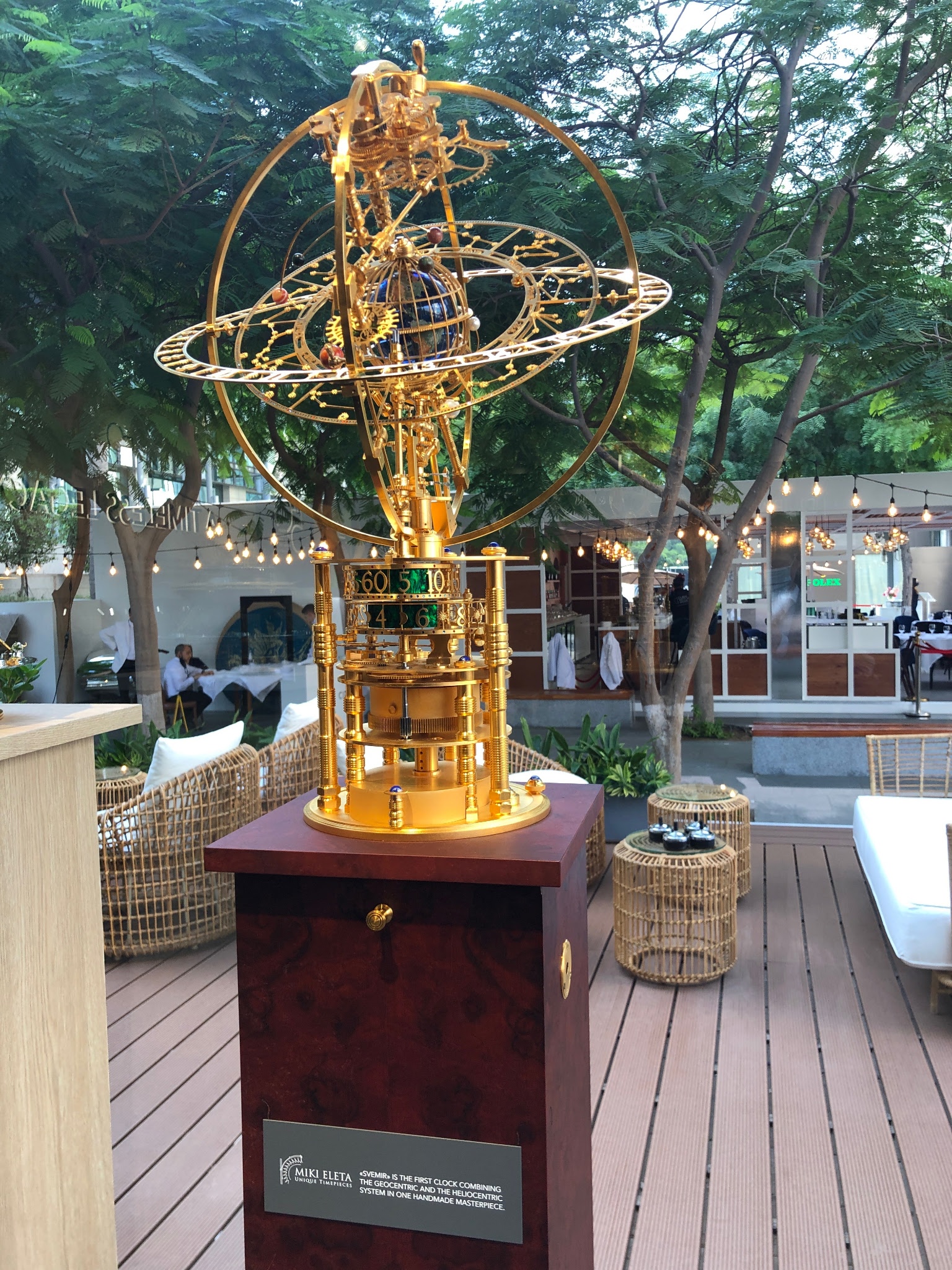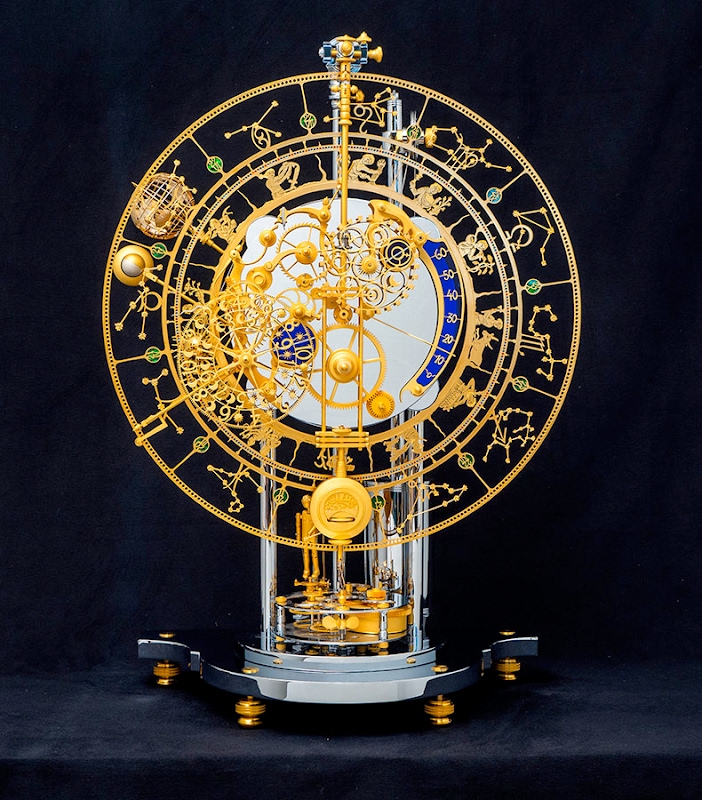
patrick_y
[PuristSPro Moderator]
31715

Miki Eleta – The Clockmaker Who Established a whole new Category!

“Category defining” is an attribute we only bestow upon those who are true artists. Enter Miki Eleta, an artist who has been making mechanical devices and clocks for about 20 years. But despite his many years of professional work, Eleta has only produced 40 timepieces. Averaging only around 2 pieces a year. His works are housed in the private palaces of Royals, the homes (and one yacht) of industry leaders, and to my knowledge a couple PuristSPro members. In 2021, a favorite selection for the GPHG Grand Prix of Horology was Miki Eleta’s Svemir – Serbo-Croation for Universe – as it was one of the finalists for the Mechanical Exception Prize. While it didn’t win the category nor the show – that honor went to the Bulgari Octo Finissimo – it started an incredible debate and the creation of a whole new category! A clock category now exists in the GPHG selection 2022, thanks to Miki Eleta. History is in the making…

An Introduction To Miki Eleta
Miki Eleta was born in Bosnia and Herzegovina in 1950 and now lives in Zurich with his spouse of many decades. They’ve raised a family together and are enjoying the company of their grandchildren. In addition to making clocks, Eleta also enjoys nature and tending to his garden. I spent two days with the artist and realized his beautiful creations are in part thanks to his constant quest to surround himself with natural beauty. Despite crafting some of the finest clocks in the world for some of the most important people in the world, he eschews superfluous luxury goods, he doesn’t even keep a car, he’s a real fella, a craftsman – not a polished brand CEO with a slick haircut, a perfectly trimmed beard, and a perfectly ironed shirt – NO! Eleta comes off as a joyful slim version of Hagrid from the Harry Potter books with a genuine bit warm smile in a plaid shirt and khakis.
I spent two days with the artist visiting his studio and home in Zurich. During this time I discovered Eleta often spends mornings working in his garden, sometimes having lunch in his garden. He and his wife treated me to a lovely lunch of a nice salad and Bosnian style sausages that he grilled in his garden. For dessert, we picked raspberries and lingonberries that were growing in his garden and ate them together while talking about current events and joking about past experiences. Apparently, Miki Eleta once lived in Spain for a few months to learn how to play the Flamenco guitar. He gave me a demonstration and I was impressed – what a romantic! Eleta believes in being in harmony with nature, sometimes going for walks in nature often stopping to smell the flowers. I found his behavior fascinating – Zurich is one of the most expensive cities in the world and one of the most highly strung financial capitals of the world, yet here’s a man who absorbs its beauty. It reminded me to remember what is important.

The Creations
I realized something – Eleta is not only an artist, he’s a
creator – in the Investment Banking world there is always the intention to
create value. Eleta absorbs nature,
love, family, his fascination of the cosmos, and he distills these experiences
into mechanical engineering to create his incredible clocks. To call his creation a clock is almost an
understatement, as they are a combination of sculptures, automatons, and
time-keepers. If he were making an
alcoholic spirit, it’d be one with a high proof – his creations are quite substantial
– bottled at cask strength (not watered down), the clocks are presented in a
very pure form. Some of the clocks have
six note chiming mechanisms, the sequence of which are not repeated for a few
hundred years. Other clocks have
celestial complications. Others are
purely fantastic – fantastic in the traditional meaning of deriving from a
fantasy – the alien fantasy and the minute muncher fantasy are all personal
self-creations that Eleta dreamed of himself.

Perhaps the favorite Miki Eleta clock amongst journalists is Eleta’s “BY21Dez12ME” (BY and ME stand for Bolon Yokte and Miki Eleta, respectively) a timepiece/automaton/sculpture that celebrates the Mayan date that signified the end of the world. 21-December-2012 was the date when the Mayan calendar ended; signifying that the Earth would end or the calendar would restart. Before you dismiss this as ancient folklore, keep in mind the Mayan astronomers have credibility; they already calculated that the planet Earth had 365 days in a year and made other very sophisticated astrological and horological discoveries with the limited technology they possessed over 2000 years ago. Back to the modern day, 21Dez12 is a tourbillon clock with playful dancing glass aliens and a large circular spaceship. The entire clock is powered by a huge gravity tourbillon that looks like the spaceship’s antenna array. At 405,000 Swiss Francs, it’s a substantial investment. But it’s a unique piece that combines three functions; an incredible sculpture, an automaton, and a very complicated clock. Kinetic art at its finest.

Minute Muncher is a visually impressive piece – at first glance it looks like a gold cake – that hides a fun side to it. A beautiful and impressive circular clock, it features a mechanical animal that eats the time. The numerals appear topside in circular cutouts, but as the animal comes, the numerals disappear! A fun automaton creation that appears simple, yet was incredibly difficult to create. Created in gold plated brass, a titanium moon, and Lapis Lazuli, there are more than 600 pieces that comprise Minute Muncher; and an incredible eight months were required to assemble Minute Muncher. This visually stunning and playful piece is offered at 250,000 CHF.


Svemir, arguably Eleta’s most famous creation, is a clock of special recognition. It’s a clock that created history since it was arguably the clock that GPHG jurors were admiring when they thought that there should be a clock category. Svemir, a large three dimensional clock, needs to be appreciated in person – as it is a grand and imposing piece of machinery in person. The three dimensionality of the clock displays Earth as rotating around the Sun (HELIO-centric). But it also presents a leit-motif of what if the universe rotated around the Earth… The Earth (Geo-) centric concept embraced by many religions in centuries past until Nicolaus Copernicus’ Helio-centric model was published. The concept took years to create, dozens of drafts. Actual construction time took over 9 months. This is perhaps one of Eleta’s grandest creations in size, difficulty, concept, and ambition. A career defining piece. Priced at 340,000 Swiss Francs.

Another one of Eleta’s creations, perhaps this journalist’s
personal favorite, The Passage of Time, again celebrates the Cosmos while
reminding us, the man represented as an automaton, that we are short-lived and
that the universe is infinite. The outer
disc shows the months, zodiac signs, agricultural harvest cycles, and makes one
revolution per year Overall, the clock displays the time in an incredibly
meaningful way and extravagantly elegant way.
Construction time required 10 months, but planning and design required years. Offered at 325,000 Swiss Francs, this timepiece elegantly combines a
calendar complication and an automaton in an incredibly elegant package. There will only be one piece.
The passage of time - Miki Eleta from Miki Eleta on Vimeo.


Eleta’s latest creation, finished in 2022, and his 40th piece, is the Hammock Clock (pictured above). A charming clock that features a musical chime complication, a gigantic 128 year moonphase, and a 24 cities timezone disc. The six hammers strike six notes creating a melody that will not be repeated for about 300 years! The metal case design shows a man who lives a charmed life daydreams on a hammock, perpetually watching the moon wane and wax, listening to the chiming melody. Offered at 150,000 Swiss Francs, this beautiful piece not only pleases the eyes, it also chimes audible melodies.


The Craftsmanship
In addition to hand craftsmanship – Eleta himself personally uses a tiny saw and file to saw and file out all of these creations – all of the clocks mechanics are his own design, he doesn’t follow any established formula nor ETA “base movement” architecture. Eleta is also a one man team. He eschews supercomputers, instead designing his clocks by hand using his own paper blueprints. He doesn’t have a single CNC machine, as he cuts each gear himself by hand without using advanced computer guided machinery. Each completed piece is a thought of what he wanted to create and how he wanted to create it. The following words may be very descriptive to some, but totally uninformative to some – but Miki Eleta is a romantic – his creations are truly creations of love. Eleta tends his garden with physical weeding, watering, sunshine, and love. He is powered by food, walks in the beauty of nature, love from his wife and children, and sunshine. And all of that food, sunshine, nature, family, and love is distilled into a concentrate and mixed with some metal and craftsmanship to create his timepieces – each of which are unique works of art.
Conclusion
These pieces by Miki Eleta need to be seen to be appreciated – they’re visually impressive and grand pieces – but since they are objects that never leave the home, they are also stealth wealth assets. Original art is the closest comparison; like a Monet, Eleta’s pieces grace the finest homes, private museums, and even some Royal palaces. And unlike exotic automobiles and gold wristwatches, Eleta’s creations are not intended to be extremely portable, eschewing the consumer who only buys things to show off to others. With only about 40 pieces in circulation in the world, Eleta’s work is rarer than any of the famous artists – Picasso is estimated to have created 40,000 pieces in his lifetime, approximately 600 Stradivarius violins are estimated to have survived over the years. Yet, despite such a small body of works, the achievements and accolades attributed to Eleta are extensive. Eleta has also displayed his works in numerous museums and galleries, including Baselworld, the Saatchi Gallery London, Musee Internation d’Horlogerie La Chaux de Fonds, Uhrenmuseum Beyer Zurich, Dubai Watch Week and more. And finally the GPHG is now honoring Eleta with a new category, the 2022 GPHG will be the first year with a Mechanical Clock category. This will surely increase the exposure of clocks to the press and to collectors. The popularity of clocks in the global marketplace will likely increase tremendously in the coming years. Time to make some room in the home for a clock!
